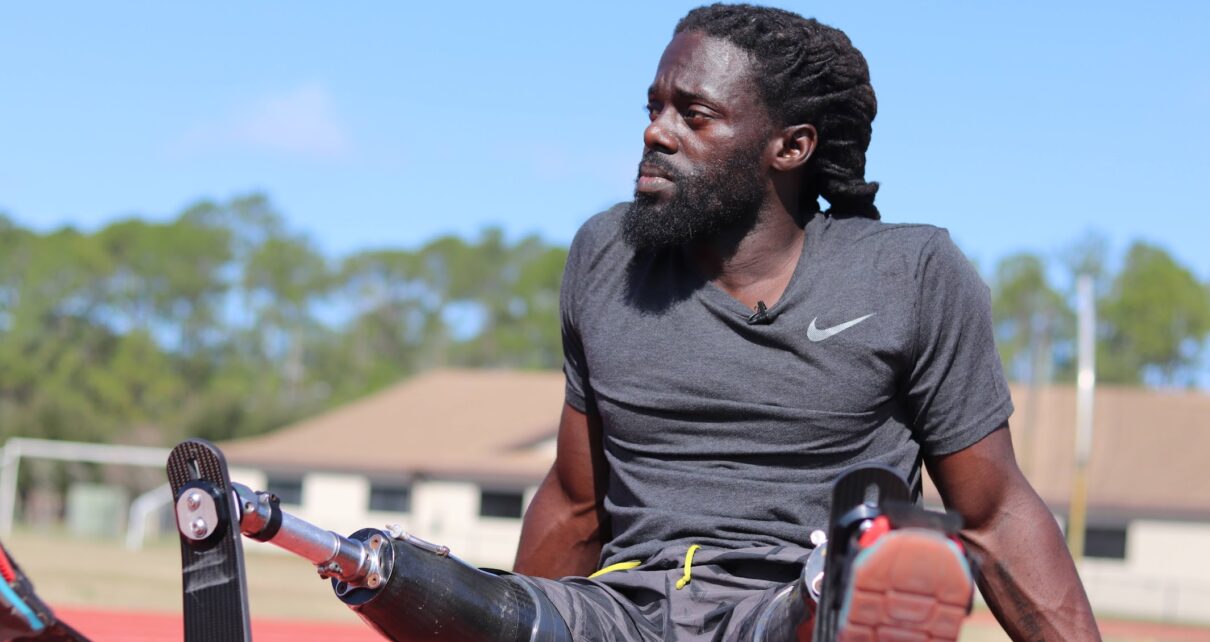Run, Regas Run:
The sun beats down on the rough, rigid rubber track at Ocala’s Trinity Catholic High School.
School is in session but no students are on the track today. The clear skies overlook just one runner, a student of the game. He trots back and forth, preparing himself for the sprint of his life. Physically. Mentally.
Then, he sets his stance, gathers his balance and explodes off the line.
Regas Woods leaves all his imagined competitors in the shadows, shouting as he reaches top speed. It takes almost everything out of Woods to sprint like that just once. But he does it again. And again. And again.
“Long as I’m breathing,” he says, “we working.”
He lies on his back in the shadows on the hot track after a rigorous day of training, closes his eyes and rests. The 39-year-old can see his future this summer in Tokyo, representing the United States again as a Paralympian. He can see his 13-year-old son, LJ, watching and cheering him on. And he envisions the struggles he’s encountered over the last four years, relearning how to run because of variables out of his control.
Another day of training is complete. As his body begins to cool, Woods gathers himself, sits up from the floor and takes off his legs.
Woods was born in Dunnellon with a congenital anomaly that didn’t allow his tibia and fibula to properly develop. His mother, Deborah, was given the option to either amputate both his legs at age two or six due to his condition. She opted for the earlier age so he wouldn’t know anything else.
“A lot of people don’t do things because they don’t know that they can do it, they think it’s impossible,” Woods says. “But being an amputee, it’s a fight every day.”
An above-the-knee bilateral amputee, Regas struggled with the mundane tasks of life. He avoided crowds. He shied away from attention because he felt all eyes fell below his waist rather than his face.
“The worst feeling for a human being, especially a child, is to not be accepted by their peers,” Woods says. “So it was one of those things where — now, we have the term bullying — I experienced bullying before it was bullying.”
But he hardly shows any evidence of his traumatic childhood in the way he carries himself now. He stands much taller than the 5-foot-10 height his prosthetics give him. His infectious smile and bubbly personality make the runner the star of his own show. One second, Woods locks in at the line. The next, he laughs with a stranger.
Once at the 2017 World Championships in London, an exhausted Woods had just finished competing in the long jump. After recording his best jump of the day, security promptly escorted him towards a TV camera for a timely post-jump interview with NBC. But Woods saw a different opportunity.
Lined in the front rows were school kids of all ages, enjoying the event free of charge thanks to the World Para Athletics committee. Woods had put on a show for the kids all day, crediting their energy as a crucial boost for him. With his day finally complete, he figured he’d do something for them in return.
A lot of people don’t do things because they don’t know that they can do it, they think it’s impossible,” the U.S. Paralympian said. “But being an amputee, it’s a fight every day.
As he was being escorted, Woods burst away from security just as he would after hearing a starter’s pistol, hurdled a barricade and leaped into the stands. Chaos ensued, along with selfies, autographs and smiles. Mostly smiles. Woods was eventually escorted back onto the track, but not before one final escape to nab one final selfie with a fan.
You got to give the fans what they want because those are the people that support us,” he said. “I mean, I was hurting. I was dead tired from jumping the six jumps. I was hurting from previous races. But I put a smile on my face and I went out and did it. That’s what it’s all about, man.”
“Anything for the kids.”
Woods hasn’t allowed a lack of legs to stop him from truly doing anything. Perform in an ATV stunt show, cranking some flips in front of cheering crowds? He’s done that. The ability to play four instruments, along with a good set of singing pipes? Woods does that too. The World Champion Paralympic athlete was even told it would be impossible for him to run when he first attempted to race in track and field. No sanctioned race had ever been held with above-the-knee bilateral amputees, other than in wheelchairs. Woods laughed.
“For so many years of hearing, you can’t do this, you can’t do that, you can’t run, you can’t jump, can’t drive a car, you can’t play this, you’re not gonna be able to walk, you’re not gonna be able to do this,” he says. “And to be able to say, ‘You know what, I can. I don’t care what you say. I can do it.’”
I’m going to be the fastest 5-foot-4 joker on the planet.
From qualifying for the Paralympics on another man’s prosthetic (after one of his broke, he was forced to borrow a friend’s to continue competing) to getting laid off from his job for being away too long while competing in those Rio Paralympics, one could say Woods has an adequate amount of experience overcoming adversity. But over the last three years, the most difficult challenge Woods has had to face is one he never expected.
In 2018, the International Paralympic Committee implemented a new formula to better measure double-amputees Measurable Assessment of Standing Height (MASH). Unfortunately for Woods, his long wingspan and small trunk didn’t mesh well with the novel formula. Despite racing at close to 5-foot-10-inches his whole professional career, including the 2016 Games in Rio, Woods was shortened down to 5-foot-4.
“I’ve always been a fighter. I’ve always overcome adversity,” he says. “And you’re just not going to get rid of Regas Woods like that.”
Shortened down close to six inches to what Woods competed at his whole life, he essentially relearned how to run. He’s yet to match his top speed compared to his old height, despite more than three years of training on his new prosthetics, he says. Woods was also forced to buy these new, shorter prosthetics which ranged in the thousands of dollars. Though the formula affected many athletes, including other Americans, it’s not difficult to see that the rule especially didn’t do Woods any favors.
“Regas is an unusual body type,” former Director of U.S. Paralympic Track and Field Cathy Sellers said. “He has an extremely short trunk and extremely long arms, and those two factors change the dimensions of his part of the formula.”
“Regas is probably the one that’s been the most dramatically affected.”
Though many in the 39-year-old’s position would just complain and quit, Woods has vowed to not give in. Adversity, like the rule change, doesn’t change the way he thinks or works. According to Woods, this formula will only make him stronger. He believes he’ll step away from track and field on his own terms and on one condition: Beating this formula and becoming “the fastest 5-foot-4 joker on the planet”.
Woods’ “Never Say Never” mantra, which he’s preached in interviews and worn on his chest, isn’t just another phrase he likes to repeat. He wants to prove that making excuses isn’t acceptable.
We want to be those guys that step in and say, ‘Hey, you can do it. Never say never.’
In 2010, Woods and his friend Nick Stilwell, another double-leg amputee, created the Never Say Never Foundation, a non-profit which reassures kids that there is life after amputation. The foundation teaches kids and young adults to overcome adversity with a positive attitude, encouraging them to try a multitude of sports, like track and field, and even some extreme sports like motocross and ATVs.
Because insurance doesn’t deem prosthetics such as running blades “essential,” it refuses to cover the hefty costs of these pretty necessary running blades. Doing simple athletic tasks like running and jumping on those “essential” legs is nearly impossible compared to the blades, creating a massive barrier to entry for those wanting to participate but unable to afford them. Woods and Stilwell saw an opportunity to impact the lives of others and stepped in, creating this foundation to be that necessary provider.
In the 10 years since its creation, Woods and Stilwell have given over 100 prosthetics to children in need.
“We’re just about helping,” Woods says. “We want to be those guys that step in and say, ‘Hey, you can do it. Never say never.’”
Nearing his 40th birthday, Woods will be one of the oldest competitors attempting to qualify for the Tokyo Paralympics this summer. He loves it, though. The “old man on the track” still has a lot left to give to the sport, he says.
“Either you want it or you don’t,” he says while lying down on the Ocala track, slowly regathering his strength. “So as long as I’m breathing, we working.”
With his training session complete, Woods looks to the sky in his restful stance. As clouds begin to move in, he stands up and leaves the empty track behind him.
Another day completed, but the work is hardly finished. For Woods, it has only just started.










